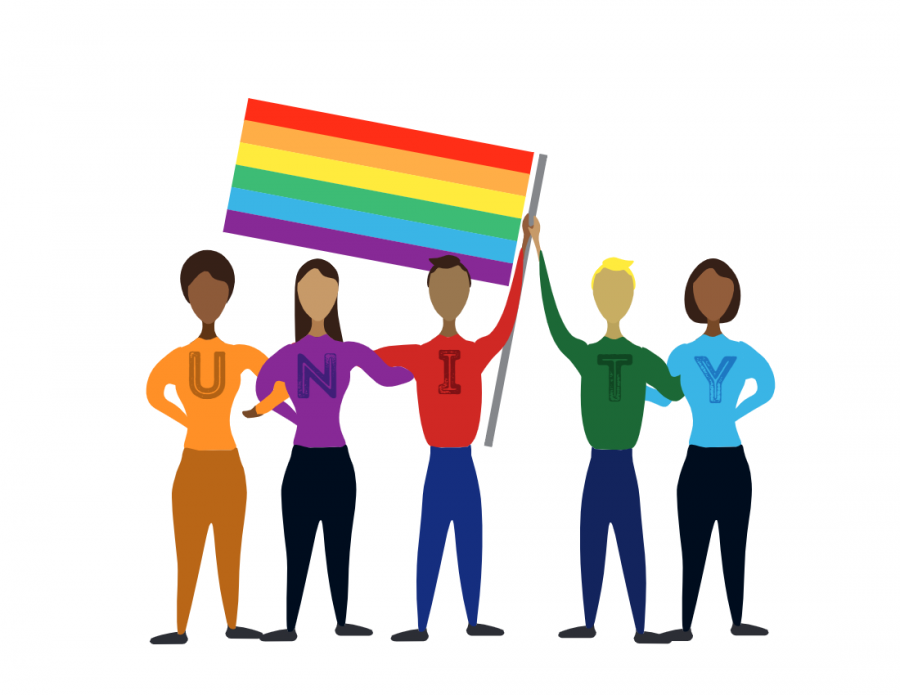Editorial — LGBTQ+ students deserve representation in educational settings
October 26, 2022
The Gwinn Area Board of Education decided at an Oct. 17 meeting to stand firm on its banning of pride flags from school classrooms. The ban comes despite public outcry from concerned parents, faculty and surrounding community members.
Undeterred by public protests, including a formal letter written by two Northern Michigan University students that garnered nearly 400 supporting signatures, the pride flag ban at Gwinn Area Community Schools was imposed because the flag is considered to be a political symbol by the Gwinn Area Board of Education.
According to the Mining Journal, Gwinn Area Community Schools superintendent Brandon Bruce stated that he was advised by legal counsel that the flag is political in nature, which violates current school policy regarding the display of flags. However, we take issue with defining the flag as “political.”
Considering the heightened political polarization in America that began at the turn of this century, we can assume that the term “political” was being used colloquially in Bruce’s justification for keeping the ban in place.
To clarify, an LGBTQ+ flag is not inherently political. It does not endorse a political candidate, support a political party or promote any political ideology.
According to the University of Colorado’s Gender and Sexuality Resource Center, the rainbow pride flag made its first public appearance in 1978. Created as an emblem for the gay community, each of the colors on the flag represents a unique characteristic that illustrates hope — an idea that is often associated with rainbows.
The colors on the rainbow pride flag represent ideas and values such as life, healing, sunlight, nature, harmony/peace and spirit.
As we consider the true meaning behind the pride flag — a symbol of hope, community and inclusion — we believe it would have been more appropriate for the flag to be labeled as “politically controversial” by the Gwinn Area Board of Education, not political.
We acknowledge that any issue that is considered “controversial” by a significant margin of the population is often synonymous with American politics, especially when candidates from one party or another use their stance on such an issue to boost their support during campaign season.
So, while the flag itself is not a political symbol by any means, public sentiment regarding LGBTQ+ rights due to extreme political polarization has forced the pride flag to be a central talking point in America’s political arena.
While the rights and equal representation of LGBTQ+ people should not be up for debate in 2022, we continue to see this marginalized community attacked by political leaders across the country on a daily basis.
For instance, health care for transgender youth seeking gender-affirming care was recently stripped by legislators in Florida. In another case, the Supreme Court’s overturning of Roe v. Wade included a comment from Supreme Court Justice Clarence Thomas, in which he stated that Lawrence v. Texas and Obergefell v. Hodges – two landmark cases in support of gay rights – should be reconsidered.
Rather than arguing the logistics of the Gwinn Area Board of Education’s decision, however, we will be discussing the benefits that accompany adequate LGBTQ+ representation for queer youth in educational settings.
The Trevor Project, a national non-profit organization dedicated to suicide prevention efforts for queer students, found that “73% of LGBTQ youth [ages 13 to 24] reported that they have experienced discrimination based on their sexual orientation or gender identity at least once in their lifetime.”
According to the American Bar Association, “a young person’s experiences in school can have a particularly important influence on their academic and social-emotional growth, physical health and mental well-being.”
In order for American youth to reach their full potential, then, the schools in which they attend must harbor a sense of belonging, safety and positivity.
The American Bar Association continues, stating that an increased perception of belonging amongst LGBTQ+ students, particularly through an “LGBTQ-inclusive curriculum,” correlates with higher rates of student well-being and positive perceptions of the school’s environment.
In fact, schools that affirm LGBTQ+ youth and their identities have a lower risk of suicide attempts within the queer community. According to the Trevor Project, “LGBTQ youth in affirming schools had nearly 40% lower odds of attempting suicide compared to LGBTQ youth in non-affirming schools.”
Representation in schools, whether it be a pride flag hanging on a wall or more inclusive curriculums, contributed to this statistic.
We have seen the negative consequences of schools conveying the idea, deliberately or not, that LGBTQ+ topics and individuals are “inappropriate” as well. According to the Gay, Lesbian & Straight Education Network, the labeling of specific school activities as non-LGBTQ+ has “prevent[ed] LGBTQ students from participating in the school community as fully and completely as other students.”
Considering how much time students spend at school, these institutions must have the qualities that make it a safe space for them to thrive both academically and personally. Educators and administrators owe it to their students, for the physical and emotional well-being of youths depend on their perception of self-worth.
People do not choose to be queer, so the LGBTQ+ community will continue to exist whether a flag is flown or not. However, the decision to remove the pride flag from an institution that is dedicated, by definition, to education and community is telling of the attitudes and values that are likely to dominate the school environment.
As Gwinn School Board Trustee Mary Jo Paris-Johns said during the pride flag removal discussion, “People get threatened. People get beat up … A flag isn’t going to stop it.” While this may be true that a pride flag will not prevent bullying against LGBTQ+ students, the removal of these flags opens the gates for increased homophobic and transphobic behavior as LGBTQ+ students are publicly dismissed by administration.
The explicit removal of these flags will impact the children of Gwinn schools more than the subtle presence of them on the walls of a classroom ever did.
Editor’s Note: The North Wind is committed to offering a free and open public forum of ideas, publishing a wide range of viewpoints to accurately represent the NMU student body. This is an editorial, written by the North Wind Editorial Board in its entirety. It reflects the majority views of the individuals who make up the editorial staff of the North Wind. It is the policy of the Editorial Board not to endorse candidates for any political office, in order to avoid aligning this public forum with particular political organizations.


























